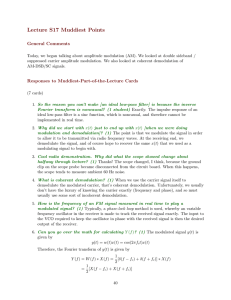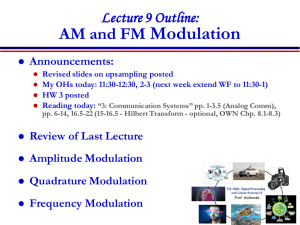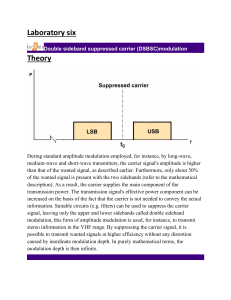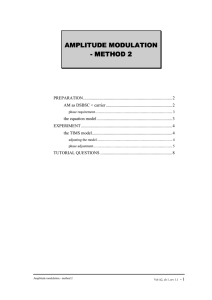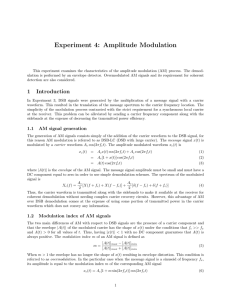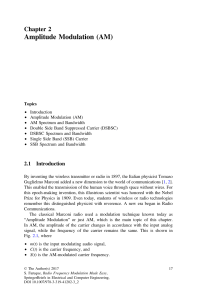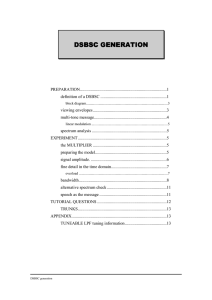Amplitude Modulation - College of Engineering, Michigan State
advertisement
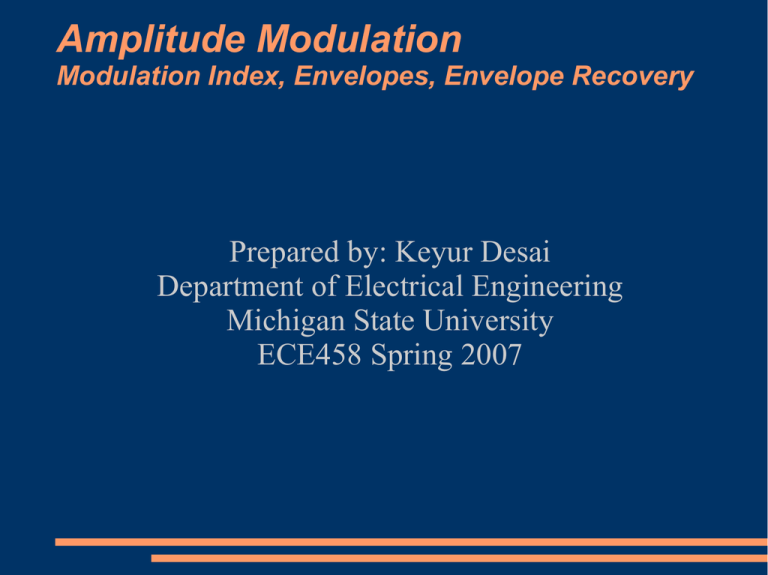
Amplitude Modulation
Modulation Index, Envelopes, Envelope Recovery
Prepared by: Keyur Desai
Department of Electrical Engineering
Michigan State University
ECE458 Spring 2007
Recall DSBSC
●
Double sideband suppressed carrier
●
●
●
In the spectrum no carrier
What is AM?
●
●
●
●
●
●
AM signal = DSBSC + Carrier
= m(t) cos(wt) + V cos(wt)
= (V + m(t)) cos(wt)
= V(1 + m(t)/V)cos(wt)
1 + m(t)/V > 0 => min{m(t)}/V > -1 => |min{m(t)}|<V
AM = amplitude modulation
●
●
●
●
●
●
●
In the message add DC
●
●
●
Add DC such that a(t) >= 0, then perfect recovery with a simple
demodulator
Spectrum of AM signal
●
●
Note the component at carrier frequency
Now you know why DSBSC was called suppressed carrier
What is Modulation index?
●
●
●
Proportion of negative change in the carrier amplitude
Amount of modulation is 0, because it's only carrier
Hence modulation index is also 0
What is Modulation index?
●
●
●
●
The minimum carrier amplitude is 0.75
When there is no signal the carrier amplitude is 3
Proportion of negative change in carrier amplitude = (3 – 0.75)/3=?
The modulation index = 0.75 = 75%
AM signal generation
AM signal generation
●
●
●
g + Gsin(ut)
g[1+ G/g sin(ut)]
Modulation index = G/g
Significance of modulation index
●
●
●
For m < 1 the boundary of AM signal has the shape of the message
For m > 1 not true
There are techniques that can extract the boundary and hence
recover the message: called envelope detection
How to measure modulation index
●
●
●
●
●
For simple signals like sin(ut) its easy to measure modulation index
For complicated signals like speech you have to use more
complicated techniques
One such technique is to use oscilloscope in X-Y mode
On X axis apply the message on Y axis apply the AM signal
Follow the procedure in the lab handout
The envelope of AM signal
●
AM signal =
The envelope of AM signal
●
AM signal =
The envelope of DSBSC signal
●
●
●
●
●
DSBSC = A [0 + m(t)] c(t)
a(t) = m(t)
e(t) = |m(t)|
Thats why envelope recovery cannot work on DSBSC signal
Then what is a good thing about DSBSC?
Types of signals
●
●
●
●
Narrowband (f2 – f1) / (f2 + f1) << 1
Wideband (f2 – f1) / (f2 + f1) >>1
Where f2 is the highest frequency component in the signal
Where f1 is the ???? frequency component in the signal
●
●
●
●
In Experiment 2 you will try to understand the how the envelopes of
wideband and narrowband signals look like
Demodulation
●
●
Also called envelope recovery in AM signal case
Recall:
●
●
●
●
●
●
●
●
●
●
●
●
How to get message back?
All you have to do is to extract the envelope
Demodulation
●
Ideal envelope detector
●
●
●
●
●
●
●
●
●
What is the circuit that gives the absolute value of the input
waveform?
Demodulation
●
How you do it in TIMS?
Demodulation
●
Didode detector
Effect of overmodulation
Spectra of AM




